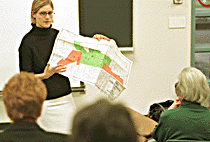

 |
|
 |
|
|
|
| Program Overview
Lehigh CORPS is multi-disciplinary, experiential, team-based
program in regional and urban economic development. It is operated
principally by multi-disciplinary teams of undergraduate students.
Summaries of All Past Projects Example Published Project Report Academic Paper
on Lehigh CORPS
Students enroll in a 3-credit, one-semester course (Eco
258) intended for juniors and seniors, although exceptional underclassmen
can enroll with instructor permission.
More Information Prof. Todd A. Watkins
|
 Lynne
Fuller ’00 presents her research findings to the Bethlehem Economic Development
Corporation. Lynne
Fuller ’00 presents her research findings to the Bethlehem Economic Development
Corporation.
-Photo by Elizabeth Keegin Colley
As finishing touches were placed on the new Perkins Restaurant &
Bakery at Third Street and Brodhead Avenue, opened in January 2000, Lynne
Fuller ’00 had more than just a new place for lunch on her mind. Fuller,
a senior majoring in political science and economics, helped the Bethlehem
Economic Development Corporation (BEDCO) survey the Perkins site for possible
business use. She sees the new restaurant as another step in her efforts
to inject a new vitality into South Bethlehem. And she has bigger plans
in the works. Then, through an internship under the direction of Professor
Thomas J. Hyclak, chairman of economics, Fuller helped develop a renovation
plan for the South Side. She made “walk-by” appraisals of residential and
business properties in the Five Points area and the Fourth Street corridor,
taking note of their aesthetic quality, structural deficiencies, parking
availability and traffic patterns. Fuller and Drew Griffin ’00 also met
with BEDCO and the South Side Task Force to forge an alliance of community
partners charged with finding ways to revitalize areas suffering from the
loss of local business and the deterioration of buildings. “If we can influence
the improvement of just one property, it may radiate out to others,” Fuller
said. With financial help from investors and developers, Fuller hopes
South Bethlehem can experience an economic and community renewal, similar
to the renewals experienced in other areas she has studied, such as Chapel
Hill, N.C., and New Hope, Pa. Fuller, who has conducted research
at the state and local levels, cites several ways the city could improve
its image, draw more business and foster pride among its citizens. These
include giving landlords and homeowners incentives to improve their properties,
securing low-interest loans for local investors to start businesses, allocating
more parking near businesses to encourage more pedestrian traffic, and
boosting advertising for existing local businesses. Born in Philadelphia
and raised in Moorestown, N.J., Fuller doesn’t find it particularly unusual
that she’s invested so much of her time and energy into a city that has
been her home for only a few years. “Wherever I live, I want to make it
a better place,” she said.
-Kathy Frederick
|
| Example Projects
Lehigh CORPS student teams usefully and professionally contribute to client needs and at the same time learn significantly on three broadly different types of projects. |
|
The Lehigh Valley Planning Commission was interested in
better understanding the dynamics of high growth regions like Raleigh-Durham,
and how our area compared. So the student team did comparative statistical
and econometric modeling of patterns and sources of economic growth and
changes in industry mix over the past 25 years in the Lehigh Valley with
ten comparable cities nationally. This study used data from the US Department
of Commerce.
|
Undergraduate teams with guidance are fully capable of
designing and implementing useful original surveys within the semester
timeframe.
|
These typically entail researching a variety of information
sources by a mix of methods in order to make recommendations about loosely
linked policy questions.
|
|
|